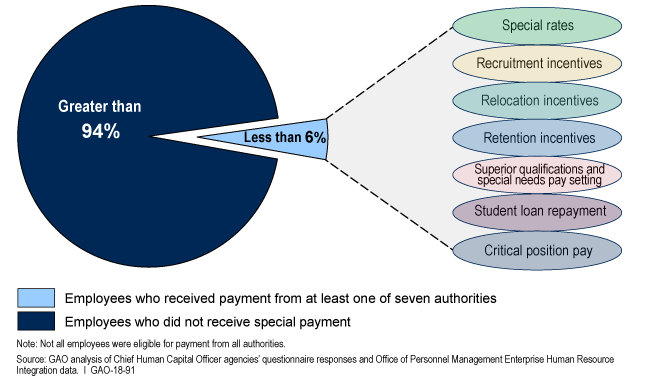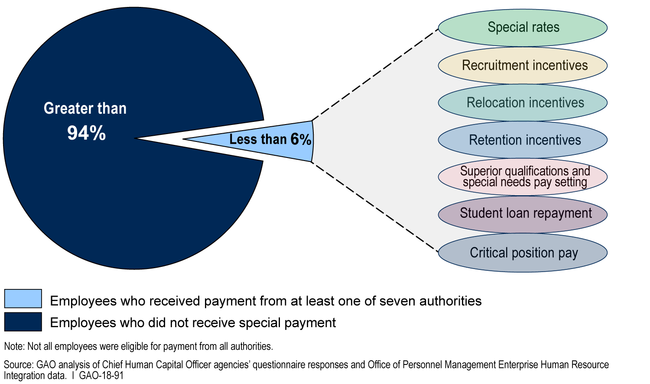Federal Pay: Opportunities Exist to Enhance Strategic Use of Special Payments
Fast Facts
Federal agencies can tap an array of incentives when they need to recruit or retain experts in cyber security, engineering, or some other in-demand field.
Seven special payment authorities allow agencies to pay higher wages, help pay off student loans, and offer other incentives.
We found that less than 6% of employees received special payments. Agencies reported that incentives were helpful, but few documented their impacts, and the Office of Personnel Management has not assessed their effectiveness.
We recommended that OPM track incentive impacts, identify needed improvements, and guide agencies on assessing effectiveness.
Federal Agency Employees Receiving Special Payments in Fiscal Year 2016

A pie chart shows that less than 6 percent of federal agency employees received special payments in fiscal 2016.
Highlights
What GAO Found
Generally, federal agencies have seven broadly available government-wide special payment authorities to help address recruitment and retention challenges. Chief Human Capital Officer (CHCO) Council agencies reported using these authorities to varying degrees but overall for few employees in fiscal years 2014-2016. For example, in fiscal year 2016, less than 6 percent of the over 2 million CHCO agencies' employees received compensation from at least one of the authorities (see figure). The two most frequently used—special rates and retention incentives—were used for over 74,000 employees and over 13,000 employees, respectively, each year. The least-used—critical position pay—was used for as few as seven employees a year. CHCO agencies also reported using the range of authorities to help address skills gaps, particularly for science, technology, engineering, and mathematics occupations.
CHCO Agency Employees Receiving Special Payments, Fiscal Year 2016

CHCO agencies reported that these authorities had positive impacts—such as on-staff retention and applicant quality—but had few documented effectiveness assessments. Nine of 10 agencies that reported having documented assessments provided them, but GAO found that only 3 had information on effectiveness, such as its impact on meeting staffing needs.
The Office of Personnel Management (OPM) collects agency data on use but has not tracked data to analyze how much authorities help agencies improve recruitment and retention government-wide. OPM may be missing opportunities to promote strategic use by providing guidance and tools on assessing effectiveness. For example, OPM has not explored reasons for trends in use of critical position pay or consistently shared best practices and innovative ways to use authorities. Without tracking data and providing guidance to help agencies assess effectiveness, OPM will be unable to determine whether use of special payment authorities helps agencies to improve recruitment and retention.
Why GAO Did This Study
Federal agencies can provide additional compensation by using seven broadly available special payment authorities to recruit and retain employees to address needed skills. Though special payments can help fill mission-critical skills gaps, agencies also face constrained budgets, which underscores the importance of cost-effective use of authorities. OPM and the CHCO Council play important roles in assuring effective federal human capital management.
GAO was asked to examine agency use, challenges, and improvements needed, if any. This report 1) describes CHCO agencies' use of special payment authorities in fiscal years 2014-2016; 2) assesses to what extent CHCO agencies examined effectiveness; and 3) evaluates how OPM has helped agencies address recruitment and retention needs. GAO obtained information from CHCO agencies on use of authorities through a questionnaire. GAO also analyzed OPM personnel data and agency documents, and interviewed agency officials.
Recommendations
GAO is making three recommendations, including that OPM should work with the CHCO Council on tracking data and providing guidance and tools to assess effectiveness of authorities, among others. OPM concurred or partially concurred with all recommendations, and described planned steps to implement them.
Recommendations for Executive Action
| Agency Affected | Recommendation | Status |
|---|---|---|
| Office of Personnel Management |
Priority Rec.
The Director of OPM, together with the CHCO Council, should track government-wide data to establish a baseline and analyze the extent to which the seven Title 5 special payment authorities are effective in improving employee recruitment and retention, and determine what potential changes may be needed to improve the seven authorities' effectiveness. (Recommendation 1) |
Closed – Implemented
OPM partially concurred with the recommendation and said that by August 2018, OPM would (1) track Governmentwide data to establish a baseline of agency use of the seven Title 5 special payment authorities by occupation with a focus on mission-critical occupations; and (2) work with the CHCO Council to determine what changes may be needed to improve the seven authorities' effectiveness. OPM said agencies are in the best position to analyze the extent to which special pay authorities, when used in conjunction with other human resources flexibilities, improve their ability to recruit and retain their employees. However, we noted that by working with the agencies, OPM would be better positioned to track government-wide data to analyze the extent to which Title 5 special payment authorities improve employee recruitment and retention. In December 2018, OPM told us that it established a baseline to measure changes over time, on an annual basis, regarding the use of the seven special payment authorities. In May 2021, OPM provided documentation showing the data OPM gathered for 2017 to establish a baseline of agency use of Title 5 special pay authorities tracked through fiscal year 2020. The Human Capital Reviews documentation OPM provided in April 2022, shows OPM's coordination with agencies to discuss any opportunities to enhance strategic use of the special pay authorities. In April 2022, OPM also provided documents demonstrating use of its data tracking and information from the agencies to address staffing difficulties by, for example, proposing legislation in March 2022, to raise the limit on special payment rates in situations where market pay for high-skilled positions is substantially above the current pay limit.
|
| Office of Personnel Management | The Director of OPM, together with the CHCO Council, should provide guidance on assessing effectiveness and tools--such as best practices or frequently asked questions--for the range of Title 5 special payment authorities. (Recommendation 2) |
Open
OPM concurred with recommendation and said that by February 2019, it would (1) develop guidance on assessing the effectiveness for the range of Title 5 special payment authorities, and (2) work on any guidance or tools that the CHCO Council identifies that would improve their use of the special payment authorities. After our report was issued in December 2017, OPM also posted new templates on its website to help agencies provide required information and facilitate the request and approval process for waivers of the normal payment limitations on recruitment, relocation, and retention incentives. We asked OPM to provide examples of related guidance or tools it provides to agencies to help them assess the effectiveness of the special pay authorities. We requested additional documentation in September 2019 and further coordinated with OPM in June 2020. In April 2021, we clarified the additional information needed and contacted OPM for an update. In May 2021, OPM provided documentation, but it did not clearly address efforts to work with the CHCO Council to provide guidance on assessing effectiveness. We requested an update from OPM in September 2021 and again in October 2022. As of November 2022, OPM informed us that it is still developing guidance on assessing effectiveness. We asked OPM for status updates in December 2022 and June 2023--including a request for a timeline and plan for implementing the recommendation--and will update the status when we complete review of any additional documents OPM provides.
|
| Office of Personnel Management | The Director of OPM should establish documented procedures to assess special payment authority requests requiring OPM approval and periodically review approval procedures to consider ways to streamline them. (Recommendation 3) |
Open – Partially Addressed
OPM concurred with the recommendation and, in December 2018, provided documented procedures for reviewing agency requests to waive the normal payment limitations on recruitment, relocation, and retention incentives; and for reviewing agency requests for special rates and critical position pay. However, the procedures generally restated the types of information that agencies must submit and did not provide criteria to assess the information supporting requests. We requested additional documentation and received updates from OPM through December 2022. In January 2023, OPM provided updated procedure documents which demonstrated progress in implementing the recommendation, as the they included questions to ask and steps to assess the sufficiency of information agencies submit with the requests. For example, the procedures for special pay rate requests included a question to guide an assessment of how various measures of pay rates for comparable jobs in non-federal salary data compare to the proposed special rate. Furthermore, the guidance on assessing agency requests to waive the normal payment limitations on recruitment and relocation incentives provided guidance to assess the success of recent efforts to recruit candidates using indicators such as offer acceptance rates, proportion of positions filled, and the length of time required to fill similar positions. The procedures documents also demonstrated progress in implementing the recommendation by referring to OPM plans, beginning in January 2024, to conduct annual reviews of the procedures to identify possible improvements, including consideration of ways to streamline the procedures. However, the format of the documents and lack of specifics on the annual reviews made the procedures appear to be in a draft or interim status. In June 2023, we requested that OPM provide documentation that the procedures are working management directives that have been appropriately internally communicated, including consideration of the audience, nature and purpose of the information, and accessibility of the information when needed to guide decision-making for assessments of agency special payment authority requests, as well as responsibilities and controls in place to prompt and conduct annual reviews of the procedures to potentially streamline them. We will update the status of this recommendation when we complete review of any additional documents OPM provides.
|
